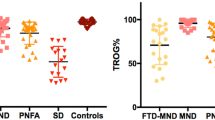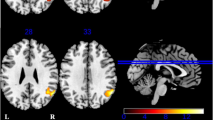Abstract
An important issue in research on language is how concepts are represented and associated with each other in the brain. Many investigations have focused on language ambiguity and the phenomenon of homonymy in which a single lexical item, presenting the same form, is related to different meanings. Our study aims to test the hypothesis that weak association of meaning characterizing homonyms may be especially prone to brain damage. To verify this hypothesis a test of attribution of the meaning of homonymous words, the Humpty Dumpty (HD) test, was applied to 50 patients with Alzheimer’s disease (AD) and 50 healthy subjects. Results show that AD patients are impaired in the HD test in an early phase of disease and that performance correlates with naming ability and phonological fluency. The data are in keeping with a growing body of literature that supports dual impairment to the semantic system in AD, i.e., to semantic knowledge and active processing and access to the semantic field. The evaluation of the ability to resolve homonymous ambiguity, using the HD test, may provide a useful and quick clinical tool to detect the anomalies of the semantic network linked to either a loss of the core system where meaning of words is stored or an impairment of the access to an intact semantic representation.
Similar content being viewed by others
References
Albert MS (1996) Cognitive and neurobiologic markers of early Alzheimer disease. Proc Natl Acad Sci USA 93:13547–13551
Taler V, Phillips NA (2008) Language performance in Alzheimer’s disease and mild cognitive impairment: a comparative review. J Clin Exp Neuropsychol 30:501–556
Henry JD, Crawford JR, Phillips LH (2004) Verbal fluency performance in dementia of the Alzheimer’s type: a meta-analysis. Neuropsychologia 42:1212–1222
Laws KR, Duncan A, Gale TM (2010) ‘Normal’ semantic-phonemic fluency discrepancy in Alzheimer’s disease? A meta-analytic study. Cortex 46:595–601
Reilly J, Peelle JE, Antonucci SM, Grossman M (2011) Anomia as a marker of distinct semantic memory impairments in Alzheimer’s disease and semantic dementia. Neuropsychology 25:413–426
Altman LJ, McClung JS (2008) Effects of semantic impairment on language use in Alzheimer’s disease. Semin Speech Lang 29:18–31
Henderson VW (1996) Introduction. The investigation of lexical semantic representation in Alzheimer’s disease. Brain Lang 54:179–183
Libben G, Jarema G (2002) Mental lexicon research in the new millennium. Brain Lang 81:2–11
Mason RA, Just MA, Keller TA, Carpenter PA (2003) Ambiguity in the brain: what brain imaging reveals about the processing of syntactically ambiguous sentences. J Exp Psychol Learn Mem Cogn 29:1319–1338
Klepousniotou E (2002) The processing of lexical ambiguity: homonymy and polysemy in the mental lexicon. Brain Lang 81:205–223
Klepousniotou E, Pike GB, Steinhauer K, Gracco V (2012) Not all ambiguous words are created equal: an EEG investigation of homonymy and polysemy. Brain Lang 123:11–21
Klein DE, Murphy GL (2001) The representation of polysemes. J MemLang 45:259–282
Tamminen J, Cleland AA, Quinlan PT, Gaskell MG (2006) Processing semantic ambiguity: different loci for meanings and senses. In: Proceedings of the 28th annual conference of the Cognitive Science Society, pp 2222–2227
Beretta A, Fiorentino R, Poeppel D (2005) The effects of homonymy and polysemy on lexical access: an MEG study. Cogn Brain Res 24:57–65
Rodd JM, Davis MH, Johnsrude IS (2005) The neural mechanisms of speech comprehension: fMRI studies of semantic ambiguity. Cereb Cortex 15:1261–1269
Klepousniotou E, Baum SR (2005) Unilateral brain damage effects on processing homonymous and polysemous words. Brain Lang 93:308–326
Rodd JM, Johnsrude IS, Davis MH (2012) Dissociating frontotemporal contributions to semantic ambiguity resolution in spoken sentences. Cereb Cortex 22:1761–1763
Frishkoff GA (2007) Hemispheric differences in strong versus weak semantic priming: evidence from event-related brain potentials. Brain Lang 100:23–43
Jefferies E, Patterson K, Lambon Ralph MA (2008) Deficits of knowledge versus executive control in semantic cognition: insights from cued naming. Neuropsychologia 46:649–658
Taler V, Klepousniotou E, Phillips NA (2009) Comprehension of lexical ambiguity in healthy aging, mild cognitive impairment, and mild Alzheimer’s disease. Neuropsychologia 47:1332–1343
Duong A, Whitehead V, Hanratty K, Chertkow H (2006) The nature of lexico-semantic processing deficits in mild cognitive impairment. Neuropsychologia 44:1928–1935
Folstein MF, Folstein SE, McHugh PR (1975) Mini mental state. A practical method for grading the cognitive state of patients for the clinician. J Psychiatr Res 12:189–198
McKhann GM, Knopman DS, Chertkow H, Hyman BT, Jack Jr CR, Kawas CH et al (2011) The diagnosis of dementia due to Alzheimer’s disease: recommendations from the National Institute on Aging-Alzheimer’s Association workgroups on diagnostic guidelines for Alzheimer’s disease. Alzheimers Dement 7(3):263–269
Reiman EM, McKhann GM, Albert MS, Sperling RA, Petersen RC, Blacker D (2011) Clinical impact of updated diagnostic and research criteria for Alzheimer’s disease. J Clin Psychiatry 72:e37
Piccirilli M, Castelli M, Petrillo S, D’Alessandro P, Arcelli P, Sciarma T, Polsonetti F, Luzzi S (2003) Modalità di attribuzione del significato in caso di omonimia e polisemia: proposta di uno strumento di valutazione del sistema semantico-lessicale. Nuova Rivista di Neurologia 13:78–84
Zingarelli N (2010) Vocabolario della lingua italiana. Zanichelli (eds)
Julien CL, Thompson JC, Neary D, Snowden JS (2008) Arithmetic knowledge in semantic dementia: is it invariably preserved? Neuropsychologia 46:2732–2744
Magni E, Binetti G, Bianchetti A, Rozzini R, Trabucchi M (1996) Mini-mental state examination: a normative study in Italian elderly population. Eur J Neurol 3:1–5
Spinnler H, Tognoni G (1987) Standardizzazione e taratura italiana di test neuropsicologici. Ital J Neurol Sci 6(Suppl 8):8–20
Bedny M, McGill M, Thompson-Schill SL (2008) Semantic adaptation and competition during word comprehension. Cereb Cortex 18:2574–2585
Bilenko NY, Grindrod CM, Myers EB, Blumstein SE (2009) Neural correlates of semantic competition during processing of ambiguous words. J Cogn Neurosci 21:960–975
Chenery HJ, Ingram JC, Murdoch BE (1998) The resolution of lexical ambiguity with reference to context in dementia of the Alzheimer’s type. Int J Lang Comm Disord 33:393–412
Rodd J, Gaskell G, Marslen-Wilson W (2002) Making sense of semantic ambiguity: semantic competition in lexical access. J Mem Lang 46:245–266
Azuma T, Sabbagh MN, Connor DJ (2013) The effect of healthy aging and mild cognitive impairment on semantic ambiguity detection. J Neurolinguistics 26:271–282
Wagner AD, Parè-Blagoev EJ, Clark J, Poldrack RA (2001) Recovering meaning: left prefrontal cortex guides controlled semantic retrieval. Neuron 31:329–338
Birn RM, Kenworthy L, Case R, Jones TB, Bandettini PA, Martin A (2010) Neural systems supporting lexical search guided by letter and semantic category cues: a self-paced overt response fMRI study of verbal fluency. Neuroimage 49:1099–1107
Costafreda SG, Fu CH, Lee L, Everitt B, Brammer MJ, David AS (2006) A systematic review and quantitative appraisal of fMRI studies of verbal fluency: role of the left inferior frontal gyrus. Hum Brain Mapp 27:799–810
Robinson G, Shallice T, Bozzali M, Cipolotti L (2012) The differing roles of the frontal cortex in fluency tests. Brain 135:2202–2214
Grindrod CM, Bilenko NY, Myers EB, Blumstein SE (2008) The role of the left inferior frontal gyrus in implicit semantic competition and selection: an event-related fMRI study. Brain Res 1229:167–178
Whitney C, Kirk M, O’Sullivan JA, Lambon Ralph M, Jefferies E (2011) The neural organization of semantic control: TMS evidence for a distributed network in left inferior frontal and posterior middle temporal gyrus. Cereb Cortex 21:1066–1075
Conflict of interest
There is no conflict of interest for any of the authors.
Author information
Authors and Affiliations
Corresponding author
Appendix: Instructions
Appendix: Instructions
“Now I will tell you a word that can have more than one meaning. For example, the word Cappuccino can either mean a drink or a monk. It is not important to give the best definition, but I want you to understand and explain the meaning of a word in every possible way, such as using other words, gestures, or even sketching it if you need to. For instance the word vite means …” (the subject is encouraged to indicate the possible meanings). “I would like you to find at least two meanings for each word that I am going to tell you”. If necessary you can provide the subjects with more examples until the comprehension of the task is clear. It is also explained that only the meanings strictly related to the words themselves are considered valid. The examiner writes down all the answers given by the subjects, but credit is not given for answers such as plurals (e.g., vite [screw] which is the plural of vita [life]) or declinations of verbs (such as lotto [lot, site] which is a form of the verb lottare [to fight]) nor are proper names taken into consideration (e.g., lotto [Lorenzo Lotto] as the Italian painter or capitale [Capital] as a work by Karl Marx).
Valid answers to each word (the percentage of valid answers given by control subjects is showed in brackets).
Homonymous words | Dominant meaning | Subordinate meanings |
|---|---|---|
Rombo | Geometric shape (90.6 %) [rhombus] | Fish (40 %), [turbot] Noise (23.7 %) [rumble] |
Articolo | Part of a speech (84.3 %) [article] | Merchandise for sale (70 %) Writing about something (39.4 %), [article] Legislative law (7.5 %), [article] Element of a religious doctrine (0 %) [article] |
Miglio | Plant used as animal feed (82.5 %) [millet] | Measure unit for distance (81.2 %) [mile] |
Batteria | A set of elements (90.6 %) [set] | Musical instrument (85 %) [drums] Infantry section (16.9 %) Chicken cage (3.7 %) Round of a sport tournament (1.9 %) |
Lotto | Game (97.5 %) | Amount of wares, part of a whole (76.2 %) |
Scorta | Body guards (94.4 %) | Stockpile (86.2 %) |
Capitale | Holdings (93.1 %) | Main city of a country (85 %) |
Percentage of subjects that produced the dominant meaning in the HD test
Homonymous word | Dominant meaning | |
|---|---|---|
Controls (%) | AD (%) | |
Rombo | 90.6 | 59 |
Articolo | 84.6 | a |
Miglio | 82.5 | 69 |
Batteria | 90.6 | 91 |
Lotto | 97.5 | 95 |
Scorta | 94.4 | 62 |
Capitale | 93.1 | 88 |
Rights and permissions
About this article
Cite this article
Piccirilli, M., D’Alessandro, P., Micheletti, N. et al. Impairment of homonymous processing in Alzheimer’s disease. Neurol Sci 36, 1331–1336 (2015). https://doi.org/10.1007/s10072-015-2085-5
Received:
Accepted:
Published:
Issue Date:
DOI: https://doi.org/10.1007/s10072-015-2085-5




